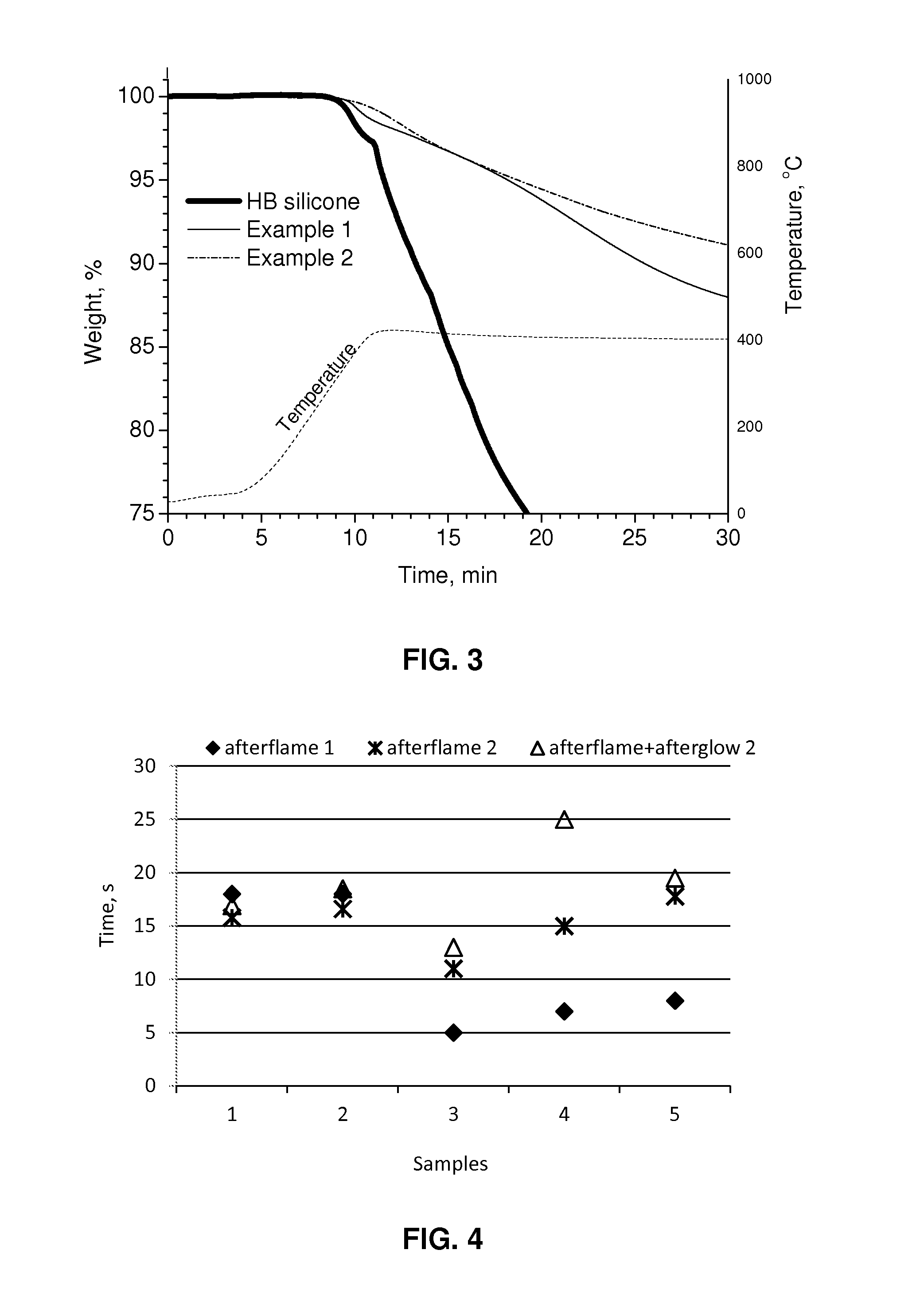Polycyclic polysiloxane composition and LED containing same
a polysiloxane and composition technology, applied in the direction of basic electric elements, electrical equipment, semiconductor devices, etc., can solve the problems of reduced efficiency and more susceptible to discoloration of phenyl silicones, and achieve the effects of reducing gas and moisture permeability, and high cross-linking density
- Summary
- Abstract
- Description
- Claims
- Application Information
AI Technical Summary
Benefits of technology
Problems solved by technology
Method used
Image
Examples
example 1
[0062]In this example, 6.1 mL of 1,3,5,7-tetravinyl-1,3,5,7-tetramethylcyclotetrasiloxane (herein referred to as D4V) was mixed with 4.3 mL of 1,3,5,7-tetramethylcyclotetrasiloxane (herein referred to as D4H), and 0.2 mL of a 50 mg / mL solution of a platinum divinyltetramethyldisiloxane complex (herein referred to as the Pt catalyst) in tetrahydrofuran (THF) was added. The mixture was pre-cured by heating at 60° C. for 30 minutes in a closed glass vial. The resulting viscous liquid was poured on a glass slide and into a metal mold, followed by curing in nitrogen at 60° C. for 18 hours and further annealing in nitrogen at 100° C. for 3 hours. The liquid on the glass slide turned into a clear coating with the thickness of 0.4 mm, while the sample in the metal mold cured into a rigid film with the thickness of 0.6 mm.
[0063]Characterization.
[0064]UV-Vis spectroscopy of the film on the glass slide was performed on a CARY-5 UV-Vis-NIR spectrophotometer (Varian, Inc.) with...
example 2
[0068]In this example, 6 mL of D4V and 6 mL of D4H were measured in separate vials. To each vial, 2 g of hexamethyldisilazane-treated amorphous silica was added and the mixtures were homogenized in a centrifugal planetary mixer. An amount of 5.7 g of the silica-D4H mixture was added to the entire amount of silica-D4V mixture. The compound was homogenized by stirring with a magnetic stir bar for 12 hours, followed by treatment in an ultrasonic bath for 30 minutes, resulting in a viscous opaque suspension. The solid samples were prepared by mixing of 2 mL of the suspension with 0.04 mL of the 50 mg / mL solution of Pt catalyst in THF, followed by curing in nitrogen at 60° C. for 3 h and annealing in nitrogen at 100° C. for 12 h. Samples in a form of a 0.25 mm coating on a glass slide and a 2 mm thick flat cast piece were prepared.
[0069]Characterization.
[0070]FIG. 1 contains the UV-Vis transmission spectrum of the 0.25 mm coating on the glass slide. The transmission in ...
example 3
[0071]In this example, a mixture of 6.1 mL D4V and 4.3 mL of D4H, and Pt catalyst was prepared as described in Example 1. The mixture was pre-cured at 60° C. for 30 minutes in a closed glass vial to increase the viscosity. To 2 g of the viscous liquid, 70 mg of a yttrium aluminum garnet-based phosphor was added to yield 3.5 wt. % of the phosphor concentration, and the mixture was homogenized in a centrifugal planetary mixer for 2 minutes, followed by pouring into a flat mold and curing in nitrogen at 60° C. for 18 hours and further annealing in nitrogen at 100° C. for 3 hours. As a reference, a typical commercial two-part methyl silicone was mixed with 3.5 wt. % of the same phosphor and cured in the mold according to the recommended procedure. Both the sample and the reference material were shaped into 10 mm disks with a thickness of 2 mm.
[0072]Characterization.
[0073]Each sample was placed on top of a blue LED (440 nm) package and inserted into an integrating spher...
PUM
| Property | Measurement | Unit |
|---|---|---|
| wt. % | aaaaa | aaaaa |
| thickness | aaaaa | aaaaa |
| thickness | aaaaa | aaaaa |
Abstract
Description
Claims
Application Information
 Login to View More
Login to View More - R&D
- Intellectual Property
- Life Sciences
- Materials
- Tech Scout
- Unparalleled Data Quality
- Higher Quality Content
- 60% Fewer Hallucinations
Browse by: Latest US Patents, China's latest patents, Technical Efficacy Thesaurus, Application Domain, Technology Topic, Popular Technical Reports.
© 2025 PatSnap. All rights reserved.Legal|Privacy policy|Modern Slavery Act Transparency Statement|Sitemap|About US| Contact US: help@patsnap.com



